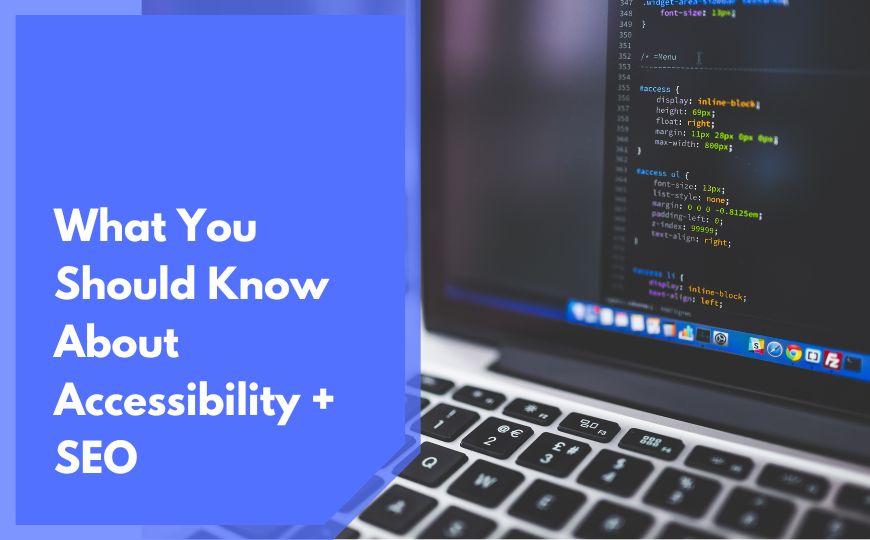A website with accessibility plus SEO
A good website should be accessible to everyone, regardless of its limitations. Web accessibility ensures everyone can use websites. In this blog, we will discuss accessibility plus SEO.
Web Accessibility and SEO
Web accessibility might sound technical or complicated, but it’s about making your website simple for all users. Picture a blind person who might be interested in buying your product or services. How will your website deliver your marketing messages to this person or another person with hearing loss? It is possible to reach people with these disabilities if your website meets web accessibility requirements. This means that you should not only focus on SEO to bring in more traffic but also ensure that once this traffic visits your website, they are able to understand your messaging, regardless of their impairments or disabilities.
Understanding Web Accessibility
Web designers and developers must follow specific standards and requirements to make websites accessible to everyone.
But this does not mean this role stops with the designers and developers, SEOs have a significant role to play too. SEOs should ensure all users can navigate, understand, and interact with websites.
Accessibility makes it possible for the visually impaired and people living with various disabilities to use websites.
These people include individuals with cognitive, auditory, and neurological impairments or disabilities.
You’ll also benefit from web accessibility if you have a temporary impairment like a broken arm.
The group of beneficiaries goes on to include people in situational impairments such as users in a moving train and environmental impairments like being in a brightly lit room.
As SEOs, it is important to ensure that websites are accessible to all types of people.
This might require collaborations with designers and developers in order to achieve this goal. However, SEOs also have specific roles to play to facilitate accessibility of websites, such as using alt tags on images.
There are some legal implications on web accessibility in some jurisdictions.
For example, the European Accessibility Act was introduced in 2019 to impose accessibility requirements within the EU.
The Act requires all operating systems, e-commerce platforms, computers, and smartphones to be compatible with assistive technologies. In addition, the devices and content should be presented in a format appropriate for all users.
Within the United States, the Americans Disability Act covers the requirements for web accessibility. This Act was first introduced in 1990 and provides that websites that are not accessible to all are perceived to be discriminatory and go against Title III of the law.
Principles of Web Accessibility
You may be wondering what you should do as an SEO to ensure that your websites are accessible and meet the requirements of relevant laws.
You should be guided by the four principles of web accessibility, which include:
Understandable: Your users should be able to understand your content. In addition, it makes it easy for users to understand the user interface and navigate the website.
Operable:
This principle requires that your websites be accessible to all people on any device they use.
In addition, your website should give users enough time to complete tasks on the platform.
Robust:
Your websites should be accessible to and interpreted by different platforms and technologies. These technologies include screen readers.
Perceivable:
You should remove any barriers that may hinder access to your content. Ensure that websites are accessible to screen readers.
You can get a full list of accessibility requirements and guidelines on how to meet them from the W3C Web Content Accessibility Guidelines.
The guideline lets you realize that accessibility requirements go beyond ensuring your sites are accessible to the visually impaired.
Improving Accessibility for the Visually Impaired
The blind and visually impaired are among the users who can benefit from web accessibility.
You can make your website accessible to the blind and visually impaired by:
Limiting and prioritizing color in the interface.
Using sufficient contrast through texture and colors.
Using explicit and descriptive labels for buttons and links.
Using headings to organize page content.
Providing keyboard accessibility.
Providing alt text or descriptions for non-text content.
Allowing users to adjust font sizes manually.
Using descriptive titles on all pages.
How SEO and Accessibility Overlap
While working on your SEO, you’re also possibly making your website accessible. But that’s not always the case.
Likewise, making a website accessible does not necessarily mean it’s optimized for SEO.
This is why it’s important to understand how and where SEO and accessibility overlap.
By understanding the overlaps, you’ll be able to optimize for both accessibility and SEO. Some notable areas where SEO and accessibility overlap include:
Image captioning.
Video transcription.
Semantic HTML.
Link anchor text.
Title tags.
Content ordering.
Size and color contrast of text.
Image alt attributes.
Header tags.
On-site sitemaps and table of contents.
The list of overlaps above shows you some areas where, by ensuring your website is accessible to search engines, you’ll also be making it accessible to all users.
For example, title tags will help screen readers and searchers.
Title tags help screen readers to differentiate the content of different pages.
Title tags also determine your display title on SERPs.
Descriptive alt text is another example of overlaps between SEO and web accessibility.
Providing text alternatives to visual elements, it’s one of the most crucial accessibility needs.
The alt texts are read aloud by screen reader technology to provide context about images to people who are blind or have a visual impairment.
The SEO benefit of alt texts is in helping search engines understand the image’s subject matter.
Conclusion
Combining SEO and web accessibility optimization is the best approach to getting all types of people to interact with your website. Whereas SEO helps you get more traffic, web accessibility ensures that nothing hinders anyone from effectively using, understanding, and interacting with the website. In addition, it is essential that your website meets the W3C guidelines as well as applicable web accessibility laws.
Looking to ensure your website is accessible and inclusive? Our team of experts can help create a tailor-made SEO strategy that delivers top performance. Learn how we go the extra mile for our clients by calling (866) 925-9524 today!






